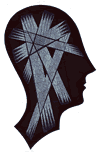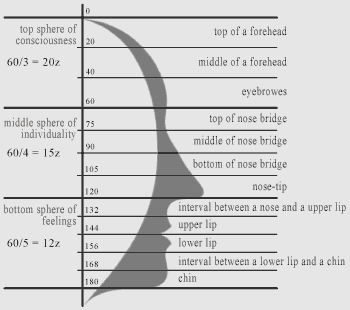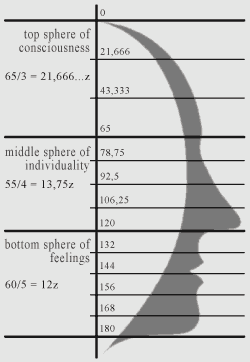| Page 1. |
 |
Physiognomy is a knowledge about proportions of a human face. The first page describes the universal physiognomic scale and special unit of measurements for proportions of a human face in physiognomy. |
-
The physiognomy is a science according to which it is possible to analyze
shapes of human faces and to consider psychological features of people according
to visible forms. But the physiognomy is not the exact science as supposes the
approximate analysis of formal facial sizes, but however in a context of
physiognomy it is possible to do exact mathematical and geometrical
measurements, and to analyze parameters of human faces according to exact measuring.
For this purpose it is necessary to apply the special measuring scale and
special measuring unit which can be named by means of the word "zenitsa" or "zenica"
that means "eye pupil" in translation from Russian. The zenitsa or a brief
spelling in English "zen" can be considered in physiognomy as the unit of
measurements, but this unit has special mathematical sense. Namely the zen (pupil) has no concrete sizes but is 1/180
part of a vertical facial size (height of a head) from a chin up to top of a
head, that is shown on the chart.
 |
The chart shows conditional shpes of a human face in
profile which consists of three physiognomic spheres: the top sphere
(forehead and eyebrows), the middle sphere (nose), the bottom sphere
(lips and chin). Each physiognomic sphere has the size 60 zens and all a human face from a chin up to top of a head has 60x3=180 zens. The top physiognomic sphere includes three facial levels, and each level has 60/3=20 zens. The middle physiognomic sphere includes four facial levels, and each level has 60/4=15 zens. The bottom physiognomic sphere includes five levels, and each facial level has 60/5=12 zens. |
Sizes of a human face from top of a head up to borders of other physiognomic
levels are the following:
- to top of a forehead 20 Zn;
- to middle of a forehead 40 Zn;
- to border of eyebrows 60 Zn;
- to top of a nose bridge 75 Zn;
- to middle of a nose bridge 90 Zn;
- to bottom of a nose bridge 105 Zn;
- to border of a nose-tip 120 Zn;
- to interval between nose and upper lip 132 Zn;
- to border of an upper lip 144 Zn;
- to border of a lower lip 156 Zn;
- to interval between lower lip and chin 168 Zn;
- to border of a chin 180 Zn.
It is possible to designate the zen in a context of physiognomy by means of
the Latin letters Zn that also means "zone" in English.
Application of the special unit allows to correlate sizes and proportions of a
human face to mathematical system according to which mathematicians measure a circle.
Namely the size of a circle is 360 degrees and the size of a human face is180 zens that is
equal to half of a circle, and consequently zens and degrees are commensurable
magnitudes. As a matter of fact the zens and degrees are commensurable magnitudes
according to the senary system of calculation which was applied in ancient
Babylon, and which is a basis of angular sizes in the modern mathematics or
geometry, and also is a basis of geodetic and astronomical measurements.
The commensurability of zens and degrees is necessary from the view point of
astrology and numerology, as comparison of zens with degrees allows to consider
physiognomy of a human face in the ratio with astrology and numerology. Namely
astrologists measure the astrological circle and aspects of planets in degrees,
and also numbers in numerology correspond with geometrical figures according to
which aspects of planets are formed within the astrological circle, and as a
result it is possible to correlate physiognomic spheres and facial levels of a
human face to degrees of astrology and numbers of numerology.
Each person has the unique sizes and proportions of a face but the special unit
of measurements allows to unify sizes by means of the uniform scale. For
example, the size of a face is 230 millimeters. It means that
the individual size of one zen unite for this man is 230/180=1,277... millimeters.
And if the vertical size of a face from top of a head up to a chin is other then
accordingly the individual size of zen unite is other, but in any case according
to the uniform unit of measurements it is possible to consider ratio of sizes
and proportions of human faces in view of the universal scale.
For measurements it is necessary to use photos as physical measurements of
facial sizes demand application of special tools, but if there is a photo then
it is necessary to place it in any graphic computer program and to
coordinate to a scale grid. Namely it is necessary to scale a photo
that the facial size from top of a head up to a chin would make 180 points of a grid,
and as a result each point of a grid will correspond to one zen irrespective of concrete
facial sizes of this or that person. Then it is possible to analyze
sizes and proportions of a face by means of the universal scale and uniform unit
of measurements.
First of all the analysis of a human face in a context of physiognomy consists
in comparison of vertical sizes of three physiognomic spheres, as correct size
of each sphere is 60 zens, but spheres can differ from correct sizes in faces of
concrete people. Namely it is necessary to calculate number of zens in each
facial sphere, that as an example is shown on the chart.
 |
The chart shows conditional shapes of a human face
in which the bottom physiognomic sphere has the normal vertical sizes,
and the top and middle spheres have the increased and reduced sizes.
Namely the top sphere has height 65 zens, the middle sphere has height 55
zens, the bottom sphere has height 60 zens, and all height of a human face
from a chin up to top of a head is 65+55+60=180 zens. Physiognomic levels of this face within three spheres have following sizes: - within the top sphere 65/3=21,666... Zn; - within the middle sphere 55/4=13,75 Zn; - within the bottom sphere 60/5=12 Zn. Proportional ratio of physiognomic spheres allow to speak about the prevailing and insufficient character traits concerning a vertical scale of measurements. The top sphere of consciousness is prevailing, and the middle sphere of individuality is insufficient, and the bottom sphere of feelings is normal in the shown example |
-
Absolute accuracy of measurements during physiognomic analyses of human faces
is not required, as absolute measurements in physiognomy does not exist, but
nevertheless allowable errors
should not exceed 1 or 2 zens. Borders of physiognomic spheres
should be determined correctly for this purpose, namely the border between bottom and middle
spheres corresponds with the bottom edge of nostrils, and the border between
middle and top spheres corresponds with the top edge of eye-sockets.
It is necessary to do measurements when the face expresses quiet emotions,
namely stays in a quiet condition. Or it is necessary to use a photo on which
the face is in a quiet condition, as lips and a chin are mobile
that can cause wrong measurements. And also it is impossible to use eyebrows as
reference points, as eyebrows are mobile and can express various emotions, namely
it is necessary to be guided on the top edge of eye-sockets for measurement of
the border between top and middle physiognomic spheres. But if
edges of eye-sockets in a photo are not visible then direct facial measurements
are necessary.
If hair hide the top of a head or if the beard hides a chin then it is necessary to
designate these facial traits that exact borders of physiognomic levels would be seen in a photo. In essence for exact measurements
in physiognomy it is necessary to do
special photos which allow to see borders of physiognomic facial traits. And also
it is necessary to do correct foreshortenings of photos which have no deviations of
facial projections from correct vertical and horizontal positions.
Also by means of zens in a context of physiognomy it is possible to
measure sizes of a human body, and it is possible to compare sizes of a face to
a stature, as proportions of human bodies can be different.
Approximately the vertical of a face makes 1/7,5 part from human stature
according to the average statistic sizes. Namely if average stature of the
person is 1760 millimeters, that corresponds to length of the measured Russian
sazhen, then the size of a face is 1760/7,5=234,666... millimeters, and
accordingly the size of one zen is approximately 234,666 .../180=1,3
millimeters. And if the face makes 1/8 part from the stature, that corresponds
to the ancient Greek canon of a body, then in this case if stature of the person
is 1760 millimeters then height of a face from top of a head up to a chin is
1760/8=220 millimeters, and the size of a zen is 220/180=1,222... millimeters.
If stature of the man is equal to the measured Russian sazhen then the size of an elbow of this man approximately
is 466 millimeters, that is equal to the ancient Egyptian cubit (it means "elbow"
in Russian) according to which sizes of the Egyptian pyramids are calculated. Namely
the approximate size of one zen is 1,222... millimeters according to the ancient
Greek canon and according to the ancient Egyptian cubit, that is possible to take into
account in mathematical calculations or in numerology. More detailed information
on statures and proportions of human bodies, and also the information on
sizes of Egyptian pyramids look on pages of other web-site:
www.phantomgallery.64g.ru/pyramid/pyr1en.htm.
The following page describes geometrical ratio which can be considered as reference points for measurements of sizes and proportions of human faces in physiognomy.
-